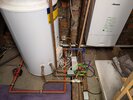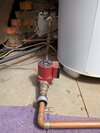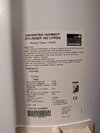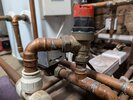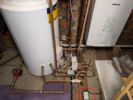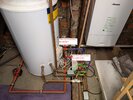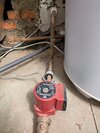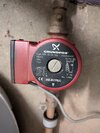- Joined
- 1 Nov 2024
- Messages
- 7
- Reaction score
- 0
- Country

Hi everyone, looking for some advice.
We had a plumber/heating engineer come round and take a look, and they just sent through a quote for an entire system replacement which might be ideal but we'd rather fix what we've got if at all possible.
I've attached some images of the setup we have. It looks like one of the previous owners installed a combi and then decided that it wasn't delivering enough pressure or hot water, so hooked it up to an unvented cylinder. The combi's hot water output has been disconnected from the hot water pipe.
Hot water is scheduled between 6-7am and 6-7pm, during which we have hot water.
After those two one hour periods, the water temperature stays hot for about an hour, then becomes tepid after two hours and stays this way for a few more hours. I'd say that about 6 hours after heating up the cylinder, we then have cold water coming from the hot tap if nobody has used the hot water.
Water heats up pretty quickly if we turn it on manually on the hot water scheduler - only need to wait 5/10 minutes before it's hot enough for a shower.
I've drawn some red lines on which pipes are warm at 10am today, and blue lines on pipes that seem to have flow going through them (I can hear running water, feeling the pipes, there's a slight vibration to them), despite no water being used in the flat (the digital water meter doesn't have the little flow icon).
Central heating seems to run through the same pipes that heat the unvented cylinder, I imagine that the two silver Honeywell valves are supposed to open & close depending on what requires heat?
From what I understand, an unvented cylinder should keep water hot for a day or so.
My questions:
Does anyone have any idea what could be going wrong here?
What is this thing that I've circled in green?
Why would a pipe heading into the inlet be warm (the pipe I've drawn a red line over)?
Thanks,
Dan
Edit: worth mentioning that our water pressure is pretty low
We had a plumber/heating engineer come round and take a look, and they just sent through a quote for an entire system replacement which might be ideal but we'd rather fix what we've got if at all possible.
I've attached some images of the setup we have. It looks like one of the previous owners installed a combi and then decided that it wasn't delivering enough pressure or hot water, so hooked it up to an unvented cylinder. The combi's hot water output has been disconnected from the hot water pipe.
Hot water is scheduled between 6-7am and 6-7pm, during which we have hot water.
After those two one hour periods, the water temperature stays hot for about an hour, then becomes tepid after two hours and stays this way for a few more hours. I'd say that about 6 hours after heating up the cylinder, we then have cold water coming from the hot tap if nobody has used the hot water.
Water heats up pretty quickly if we turn it on manually on the hot water scheduler - only need to wait 5/10 minutes before it's hot enough for a shower.
I've drawn some red lines on which pipes are warm at 10am today, and blue lines on pipes that seem to have flow going through them (I can hear running water, feeling the pipes, there's a slight vibration to them), despite no water being used in the flat (the digital water meter doesn't have the little flow icon).
Central heating seems to run through the same pipes that heat the unvented cylinder, I imagine that the two silver Honeywell valves are supposed to open & close depending on what requires heat?
From what I understand, an unvented cylinder should keep water hot for a day or so.
My questions:
Does anyone have any idea what could be going wrong here?
What is this thing that I've circled in green?
Why would a pipe heading into the inlet be warm (the pipe I've drawn a red line over)?
Thanks,
Dan
Edit: worth mentioning that our water pressure is pretty low

